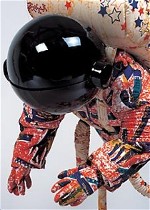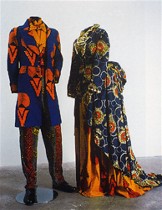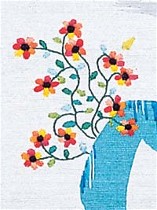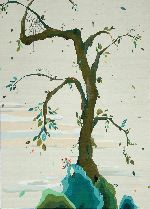 Laura Owens and Yinka Shonibare–two big names in the art world–are at the Fabric Workshop and Museum, showing work made in residency there. Owens was one of the artists included in the 2004 Whitney Biennial, and Shonibare is one of four Turner Prize finalists for 2004 (the winner to be announced in December).
Laura Owens and Yinka Shonibare–two big names in the art world–are at the Fabric Workshop and Museum, showing work made in residency there. Owens was one of the artists included in the 2004 Whitney Biennial, and Shonibare is one of four Turner Prize finalists for 2004 (the winner to be announced in December).
Space walk
Shonibare’s installation, “Space Walk,” shows a man and woman floating in an imaginary deep space (they’re hanging from the ceiling, and their space ship is reduced to a photo projected on the wall). They are connected to eachother by a tube and they are not connected to the space ship.
But they are out there in style–covered in beautifully tailored space suits made of dazzlingly busy prints with words and images from African-American pop culture icons, mainly from the Philly Sound era. There are the Delfonics and the O’Jays for example. And then there are non-Philly sound representatives like James Brown and Billie Holliday. And in a nod to the art world there’s David Hammons. The fabric and sewing were created in collaboration with the Fab.
If you look at the backbpacks and the connecting tube, you then notice that the astronauts are carrying their own stars on their backs into space (just in case you hadn’t made that connection just looking at the suit fabric). Love it.
 As I was looking I began to wonder if the famous Golden Record sent into space on Voyager included some of the Philly Sound. I didn’t find a complete list of the music included, but here’s a smattering: Chuck Berry’s “Johnny B. Goode”; “Dark was the Night, Cold was the Ground,” a 1922 song by Blind Willie Johnson; Mozart’s “Magic Flute”; a Zairian Pygmy girls’ initiation song; and a shakuhachi piece from Japan. Well, that’s pretty diverse.
As I was looking I began to wonder if the famous Golden Record sent into space on Voyager included some of the Philly Sound. I didn’t find a complete list of the music included, but here’s a smattering: Chuck Berry’s “Johnny B. Goode”; “Dark was the Night, Cold was the Ground,” a 1922 song by Blind Willie Johnson; Mozart’s “Magic Flute”; a Zairian Pygmy girls’ initiation song; and a shakuhachi piece from Japan. Well, that’s pretty diverse.
But that Golden Record was so spare. Not these two, ready to populate space with their own version of the culture we ought to be sharing. And why not? Or better yet, why share either the Golden Record or the Philly Sound? Is it just an attempt at communication or really cultural imperialism?
Are these two astronauts supposed to be dark skinned? I couldn’t tell–maybe that’s one of Shonibare’s points–since they were covered with fabric and black bubblehead helmets. He’s always been a clothes make the man kind of thinker.
 Somehow, the implications in Shonibare’s older work (image, not from this show)–detailed Victorian garb made in African-influenced fabric that really has European roots displayed on headless dark-skinned mannequins–finds its targets more easily than these space walkers do.
Somehow, the implications in Shonibare’s older work (image, not from this show)–detailed Victorian garb made in African-influenced fabric that really has European roots displayed on headless dark-skinned mannequins–finds its targets more easily than these space walkers do.
Part of that older body of work is included in the show. Two headless Victorian-era school boys sit at a desk, one with white chalk writing on a blackboard, the white inkwells spattered with black ink. The piece, again with the jazzy fabrics tailored to the nines, raises any number of race and cultural, as well as political, imperialism issues.
But my favorite piece of Shonibare’s was a series of 12 photos in which Shonibare inserts himself as Dorian Gray in a number of tableaux from the story. His presence is a sharp reminder of just how Anglo the assumptions of our lives and our literature are.
Shonibare also showed a grid of squares of stretched, patterned fabric altered with paint–a kind of dialogue between western art traditions and the wild fabrics. It felt like filler and noodling, not finished work.
The artist was born and lives in London and was one of the artists included in the controversial “Sensation” show that then-Mayor Rudolph Giuliani tried to shut down at the Brooklyn Museum of Art.
Lost in space
 Owens, a Los Angeles painter (see post below), has stretched seven large pieces of highly textured raw silk that she had silkscreened and embroidered in collaboration with the Fab. The work lacks the juicy energy of her paintings. The luscious texture of the silk and the embroidery are all but lost to the silkscreened imagery and the scale of the pieces and the huge gallery space.
Owens, a Los Angeles painter (see post below), has stretched seven large pieces of highly textured raw silk that she had silkscreened and embroidered in collaboration with the Fab. The work lacks the juicy energy of her paintings. The luscious texture of the silk and the embroidery are all but lost to the silkscreened imagery and the scale of the pieces and the huge gallery space.
The seriality here reminds me of de Chirico’s multiple versions of paintings, with a change in color here, a change in definition there, but more or less the same painting over and over (but then, it is a print, and that’s how prints work).
 I especially like the way the embroidery supplied hatch and cross-hatch details to lend dimensionality to flat areas.
I especially like the way the embroidery supplied hatch and cross-hatch details to lend dimensionality to flat areas.
Otherwise, the work, which is somewhat impersonal and highly decorative, because of Owens’ formalist and aesthetic powers, still manages beauty and energy, with its references to Japanese screen prints and storybook illustrations.
 The tree is a terrific gesture. I’m not sure I buy the expression of the passing of time and seasons, which seem tacked on as an afterthought.
The tree is a terrific gesture. I’m not sure I buy the expression of the passing of time and seasons, which seem tacked on as an afterthought.
Stretching this work like a canvas undermines its essential fabric-y luxuriousness, and places it in the paint world, where it just doesn’t deliver. I’d like to see it off the stretchers.









